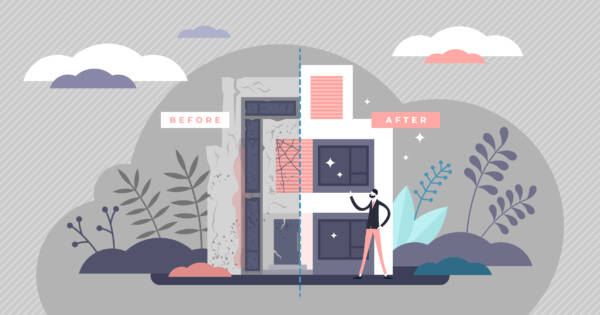When shopping around for a home, one of the first questions you should ask yourself is how much house you can afford. Understanding whether or not you can afford a specific mortgage payment — and the rest of the costs that come with home ownership — is a necessary part of the process. Make sure you don’t put this off until it’s too late. To help you better understand how this calculation works, you need to know about the 30% rule.
Why It Matters
Knowing how much you can afford to pay for your house is a vastly important piece of information. You don’t want to invite disappointment — or major financial stress — into your life by getting it wrong. Buying a house can be an emotional decision. However, you don’t want to fall in love with an available house only to realize you definitely can’t afford it. Unfortunately, the higher priced homes are almost always the most desirable.
You might think you can make it work, but the financial strain of those hefty mortgage payments will quickly have your budget at its breaking point. If you’re thinking about buying your first house (or just your next house), the 30% rule is going to play a major factor. It’s one of the most popular and commonly used financial calculations regarding home affordability.
What is the 30% Rule?
Simply put, the 30% rule states that you shouldn’t pay more than 30% of your monthly income for your mortgage. You should also lump in home insurance and property taxes into this amount. Those payments are part of the housing costs that really can’t be avoided.
Many mortgage lenders will also use the 30% rule to determine how much of a loan you qualify for. After examining your credit history, income, debts, assets, and any other liabilities, you likely won’t find many lenders offering you a mortgage that comes with payments of more than 30% of your monthly income. While you may find some lenders willing to extend the number a bit higher, the 30% mark is still an excellent rule of thumb for would-be house buyers.
 Shutterstock
ShutterstockOther Versions of the 30% Rule
Various interpretations of this rule exist. However, it’s commonly accepted that the rule applies to your after-tax income. It also applies to all of the items that go into your mortgage payment. Let’s say your property tax and home insurance premiums are all lumped in with your mortgage principal and interest. Now assume you make you make $6,000 a month, after taxes. The 30% rule says you don’t want to pay more than $1,800 a month for your monthly payment. (Thirty percent of six grand is $1,800, if you’re bad at mental math.)
If you normally pay you home insurance premiums and property taxes in an annual lump sum, you can still include them in the 30% rule. Just divide those annual payments by 12 and include the number in your calculations.
Of course, with surging house prices in many major North American markets, meeting the 30% rule is getting harder and harder. Many home buyers are needing to dedicate somewhere between 35-to-50% of their income towards their house costs.
Does the 30% Rule Make Sense?
Personally, I’m not a huge fan of the 30% rule. I think slotting almost a third of your income towards your housing costs is probably a bit steep. Depending on where you live, though, you might not have an option. In some areas, you might be lucky to keep it under 50% of your income. However, if you’re in that scenario, you should probably consider an area with a lower cost of living.
I also think you should put all of your housing costs into the equation. So add in your average monthly utility costs too. You should also factor in a cost for average annual maintenance or one-off repairs. You house may need a new roof every 15-to-20 years. Or a new appliance if an old one kicks the bucket. When you add those expenses to the mix, you’ll have even less to spend on your mortgage payment. That is, if you’re sticking closely to the 30% rule.
Other Factors About the 30% Rule
Don’t forget that a fixed percentage rule doesn’t account for income that might vary a great deal. For example, if you freelance or earn a portion of your income from sales commissions, your monthly income might swing up and down from month to month. That means calculating a 30% rule is a lot harder.
The 30% rule also starts to lose its purpose as your income increases. On one hand, someone with low income may not be able to afford anything else if they use 30% of their income on a mortgage. On the other, someone who has a very high income might be able to afford to spend 50% on housing costs, while still easily being able to afford the rest of their expenses.
 Shutterstock
ShutterstockA Quick Example of the 30% Rule
Here’s a quick example of the 30% rule in action. Joe makes $2,100 a month after taxes and spends $700 on a very modest mortgage. That means he spent 30% on mortgage payments, so he has $1,400 left to make ends meet each month.
Jane, on the other hand, makes $30,000 a month. She spends $15,000 on her huge mansion. That’s 50%, which smashes the 30% rule pretty badly. However, she still has $15,000 every month to spend on everything else. That’s a far cry from the $1,400 that Joe had. You can probably see the differences in when the 30% rule makes sense — and when it doesn’t.
What are YOU Comfortable With?
Ultimately, it has to be about what you are comfortable with in your own finances. Personally, my housing costs are under 20% of my monthly income. I can stay comfortable with my housing costs hovering that 20% mark. We were actually closer to the 30% mark when I bought my first house. I wasn’t very comfortable with that at all. It made budgeting for everything else quite tricky.
When deciding how much of your income should go towards housing expenses, it’s important to consider your own situation. It’s also worth thinking about what would happen if your situation changed. How stable is your job? Are you the sole breadwinner in the house? Or if there another income to rely on? Do you have multiple income streams? What will your finances look like if you (or your spouse) was laid off?
Your Mileage May Vary
Although my wife and I have an investment portfolio that throws off income regularly, I’m ultimately self-employed. My income isn’t as stable as someone with a traditional 9-to-5 job. I didn’t want a potential loss in business income to put my house payment in jeopardy. As a result, I like to keep those expenses under 20%. I am happier now that it’s dropped even further. That way, my family will never have to suddenly move if my income inevitably fluctuates.
My sister, on the other hand, lives in a high cost of living city. She has a very stable job. She is also on the fast track to climb the corporate ladder, with outsized raises every year. I’m not privy to all her financial details, but it’s safe to assume that her housing payments were well over 30% of her salary. However, after a few years of promotions and raises, that percentage is quickly dropping.
 Shutterstock
ShutterstockIs the 30% Rule Outdated?
You don’t have to wonder around too many financial blogs to find articles suggesting the 30% rule is obsolete. The housing prices or rental costs have skyrocketed to unbelievable levels in recent years. Many people no longer find it possible to limit their housing budget to just 30% of their income. If you run the numbers and realize you have no shot at sticking to the 30% rule, what can you do?
Well, you can ignore it. The rule has its origins in public housing regulations from the late 1960s. Those regulations capped rent for public housing at 25% of the resident’s income, which was raised to 30% in the early 80s. Of course, the economy of the 70s and 80s was a lot different than the economy of today. These days, young home buyers are likely to be carrying tons of student debt and working jobs where wages haven’t even been close to keeping up with inflation.
Is the 30% Rule Too Black and White?
Financial experts suggest that there is a “income sweet spot,” where the 30% rule makes sense. However, for those making minimum wage (or less), you’re going to almost be forced to spend way more than 30% on a place to live. On the other hand, those who make strong six-figure incomes can likely find suitable housing for much less than 30% of their income.
Those with higher salaries can also safely splurge on housing, since the remainder of their income should more than cover the rest of their expenses. In today’s modern world, many experts are moving away from the 30% rule. It’s just too rigid to be a “one-size-fits-all” rule. Everyone’s financial situation is a bit unique, after all.
A Better Rule To Follow
Let’s be brutally honest for a second: these are confusing times. The 2008 recession and the market crashes at the start of the pandemic has everyone constantly on edge about their finances. Couple that with surging housing costs and the majority of jobs doing whatever they can to pay employees as little as possible, it’s easy to be bleak about financial future.
Rather than let the 30% rule automatically disqualify you from buying a home, take matters into your own hands. After all, your personal situation will be different from everyone else’s. Even if your income is the same as someone else, that doesn’t mean you have the same expenses.
An easy example is that someone who doesn’t own a car could have a few hundred extra dollars every month to put towards a mortgage payment, instead of making car payments. Or someone who is willing to live with roommates (or a partner) will have different calculations than someone who is living alone. In short, create a detailed budget that sets aside a reasonable (and sustainable) percentage of your income for housing costs — regardless of what percentage it is.
 Shutterstock
ShutterstockThe Bottom Line
When buying a house, carefully consider your individual situation. Then think about what you would be able to handle if you ended up with a financial setback. Do you have a backup plan? That should be your guide to how much house you can afford. As for the 30% rule, it’s not just a handy calculation for you to do yourself. When you apply for a mortgage, most lenders will also use the 30% rule as a way to judge your overall financial decision. As potential lenders analyze your entire finances, they may reject your mortgage application if it looks like you’re going to be spending more than 30% of your monthly income on your new home. If that happens, you only have two choices: find a way to make more money or start shopping for a cheaper house.








